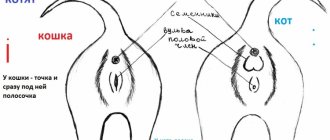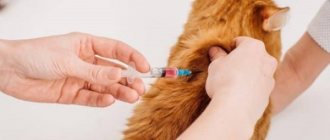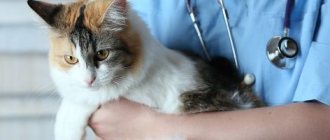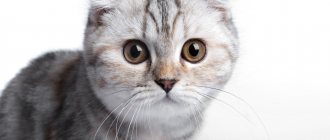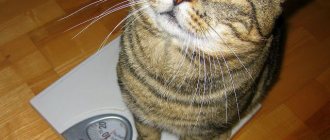Save the article:
A cat that lives at home periodically “delights” its owners with loud, heart-rending screams, signaling the onset of mating season. With its behavior at this time, any, even the best cat in the world is capable of wearing out the entire nervous system of the household. There is a solution to this problem that will save the owner from the animal’s inappropriate behavior and its consequences - this is castration of the cat .
Castration is a surgical or non-surgical intervention in a male’s body to remove the gonads. The procedure has both advantages and disadvantages, because in any case it will affect the future quality of life of both the cat and its owners.
Methods, methods of castration
In modern veterinary medicine, there are various castration techniques. The types of castration methods are divided according to the degree of intervention. The most common of them are open and closed methods. In addition, there are techniques in which parts of the pet’s genital organs are not removed.
- Surgical methods
of intervention:
- Bloody. Classic manipulations - open, closed. The open method is the main one. In this way, the testes are removed using scissors. The closed method involves cutting only the skin.
- Bloodless. This method involves castration by destroying the vas deferens, the epididymis or the entire testis. Vasectomy is a sparing method. During the procedure, the pet's blood vessels and nerves are not affected; the vas deferens are partially destroyed.
- Castration by irradiation.
The cat's sexual activity is reduced due to the effect of radiation on the testes and appendages. Although this method is non-surgical, it can cause the development of cancer in the animal. - Chemical castration.
The pet is either given a special injection or given pills that suppress sexual desire. - Chemical castration on implants.
The technique is expensive, but allows you to restore reproductive capacity in the future. The implant is injected into the cat’s skin, which reduces sexual desire after 6 weeks for a long time. - Castration-microwave
. Irradiation with microwave rays guarantees the result forever; anesthesia is a necessary condition for this procedure. The method has been proven in agriculture, but has not gained popularity in veterinary medicine. The procedure requires a microwave emitter, and the consequences have been little studied.
Traditional methods of surgical castration of cats remain popular in veterinary clinics.
Recommended castration age
Kittens can be sterilized from two months of age; the risk of complications and bleeding is low. Two- or three-year-old cats can only be sterilized under general anesthesia, since local anesthesia can be ineffective. The optimal age for defermenting a pet is from six to twelve months, but not later than seven years. During this period, sex hormones do not have a significant effect on the development of the cat’s body, while the condition of the genital organs is ideal for performing the procedure.
Local anesthesia is required in this age category, rehabilitation is quick. Also, the time that is considered ideal for performing surgical procedures is determined according to the breed, physiological state of the pet, and individual characteristics. British and Persians, for example, are considered high-risk breeds. It is best to neuter them between 8 months and a year.
The age category is not a limitation if the cat suffers from any ailments or if the owners have not decided on surgery for a long time and the animal is more than seven years old. The operation can be performed, but, in any case, the veterinarian will conduct an examination and, if necessary, prescribe tests.
Common Myths
- Myth 1. The cat will stop marking immediately after the procedure.
In fact, everything is individual, and whether a cat will stop marking after castration depends on the timing of removal of the testes. If the procedure is carried out at puberty, then the change in the cat’s hormonal levels will take some time. It happens that a cat shits after castration, thus marking its territory due to the lack of a secret. About 5% of males do not stop leaving marks at all. This problem occurs in those cats that have already been in contact with females: their hormones are produced not only in the testes. That is why it is impossible to unequivocally answer the question of whether an adult pet will mark after castration. To prevent domestic cats from marking, the operation should be performed at a young age.
- Myth 2. Neutered cats have a bad character.
Cases where a cat becomes aggressive after removal of the testes are quite rare. Animals, on the contrary, calm down and become more affectionate and tame. Males behave aggressively after castration has been carried out only due to deterioration of their condition or the appearance of any irritating factors.
- Myth 3. Castration causes cats to get fat.
Weight gain can be caused by poor diet or eating too large portions. Typically, a neutered cat will look the same as before surgery if feeding is adjusted to account for the reduction in energy expenditure.
- Myth 4. A castrated cat does not catch mice.
Many people are concerned about the question: can cats hunt after castration? In this regard, the animal continues to lead the same lifestyle as before.
These and other common myths about castration have nothing to do with reality and should not influence the decision of a cat owner.
Why is this needed? Pros. Cons and contraindications
Sterilization of felines is resorted to in order to stop or suspend reproductive function. The production of male hormones stops and, as a result:
- the cat stops screaming at night;
- aggressive behavior is replaced by affectionate behavior;
- The problem of territory marks and unpleasant smell in the apartment is solved.
- Veterinarians note other positive aspects of surgical intervention:
- the life expectancy of a neutered furry friend is 1.5-2 years longer;
- the search for the cat ends;
- exclusion of diseases such as adenoma, prostatitis, breast and anal gland tumors;
- the pet becomes balanced, obedient, and does not get into fights.
Among the disadvantages are laziness and a sedentary lifestyle, which results in obesity and related problems. Urolithiasis is also possible. To avoid these manifestations, you should adjust your diet. Anesthesia also carries some risk, especially for older cats. In addition, surgery may be accompanied by complications. It is important that the procedure is carried out by an experienced, qualified and responsible doctor.
Surgical manipulations for the purpose of defertility are prescribed only to healthy males. In veterinary medicine, the following contraindications are identified:
- liver, kidney failure;
- cardiovascular diseases;
- anemia;
- epilepsy;
- respiratory diseases, including bronchial asthma;
- exhaustion of the body;
- time before scheduled vaccination 14 days;
- 30 days have not passed from the date of the last vaccination.
In order to minimize risks, veterinarians do not recommend castrating cats younger than 7 months and older than 8 years.
Preparing the animal for surgery
Owners of a cat who is going to be neutered should remember some rules:
- the pet must be healthy, without external signs of disease;
- before the operation, the furry friend must be examined by a specialist and prescribed general and biochemical blood and urine tests;
- It is also advisable to undergo an examination by a cardiologist: it is necessary to exclude the possibility of pathologies of the heart muscle and heart diseases;
- ten hours before the procedure you cannot feed or drink the cat.
For sterilization, you will need a veterinary passport, a device for transporting a furry friend (preferably with a convertible top), a warm blanket, a disposable diaper as bedding, and napkins.
The veterinary clinic will require proof of vaccinations and deworming. In some cases, it is allowed to defertilize an unvaccinated animal using a special medicine. The presence of vaccination reduces the risk of developing dangerous infectious diseases, as it develops immunity.
Treatment against worms before castration is carried out unscheduled ten days before the procedure.
Radiation variety
Again, in our country this method of sterilizing cats is rarely practiced, which is a pity. During the procedure, the cat's testicles are fixed in a special isolating device and exposed to gamma radiation. On the one hand, this procedure is simple and requires very little time. After irradiation, the cells of the glandular tissue of the testes die, and the cat can no longer participate in reproduction. The use of anesthesia drugs is not required, the postoperative period passes in just a few hours.
The disadvantages of the technique include its high cost. In addition, there are very few veterinary clinics equipped to carry it out.
And one more thing: contrary to common “horror stories”, after such a procedure your cat will not begin to glow with a greenish light, and the radioactive background of his body will remain normal.
The processing time is only a few seconds. Gamma radiation does not leave “phoning” particles in the tissues.
Anesthesia
The operation is performed under general anesthesia. Veterinary clinics use the inhalation method, intramuscular and intravenous injections, and gas anesthesia for anesthesia.
The latter has no side effects, does not cause pain and does not have any side effects on the body. In addition, the supply of gas anesthesia is controlled during the period of manipulation: the concentration of the drug can simply be reduced or increased. With this type of anesthesia, your pet can be quickly brought out of this state.
The drugs used for anesthesia are determined by the doctor depending on the general health of the animal and other indicators. Under anesthesia, the cat sleeps, does not perceive pain, his consciousness is turned off and his muscles are relaxed. The selection of drugs is carried out individually in veterinary clinics. Intravenous anesthesia is considered the most effective.
The substance acts quickly and has no side effects on the heart and lungs. The intramuscular method has an affordable price and is considered traditional. Inhalation, in comparison with other methods, is more complex and expensive, and is rarely used.
Procedure in stages
The operation algorithm is as follows:
- Disinfection of the operated area.
- Anesthesia. The animal is restrained and immobilized. Sedatives may be prescribed several days before the procedure. Before administering an anesthetic, veterinarians mainly carry out pre-medication prophylaxis with a special drug that prevents side effects.
- Excision of testes. A qualified specialist uses disposable instruments to remove the genitals in the traditional open manner. The male's scrotum is pulled back and each layer is cut. After exposing the testis, the spermatic cord is ligated and cut 5 mm lower. The wound surface is treated with an antiseptic. Mostly, several seams are repaired or there is no need for it at all. Elderly males are sterilized using the closed method:
- scrotal incision;
- twisting of the vaginal membrane;
- thread stitching;
- establishing a ligature;
- cutoff;
- cauterization with tincture of iodine.
Recovery from anesthesia and recovery after the intervention occurs within two to three days. The cat will feel nauseous, its movements will be uncoordinated, and the animal will need increased care.
Caring for an animal after castration. Possible complications
The patient must stay in the veterinary clinic for the first hours. During this period, the doctor will be able to make sure that the cat tolerated the anesthesia normally. In the first postoperative hours, the following manifestations will be observed in your pet:
- dizziness;
- nausea;
- feeling of thirst;
- muscle weakness;
- dry eyes;
- low body temperature;
- unsteadiness of gait.
The pet can remain under the supervision of a veterinarian for the first 24 hours, but this will put him in a stressful state. Experienced doctors recommend taking the cat home. The pet needs attention and care, as well as painkillers. The groin area should be examined daily. To speed up the healing of the stitches, they are treated with peroxide and brilliant green.
To prevent the animal from licking the wound, you can wear a special collar that is removed when eating. Tetracycline ointment should be used for eye care. A warm heating pad will calm your furry friend and give him a feeling of comfort. Recovery after surgical procedures is easier in winter. In summer, you also need to take antibiotics.
At first, the cat's toilet should be bright so that the owner can notice the bleeding. You can wear a diaper with a hole for a tail. The first time after sterilization, animals experience a decreased appetite, then an increased one. You should give your cat enough water and monitor its diet. Your pet should not overeat.
Complications after surgery cannot be ruled out. The consequences of surgical manipulations are divided into:
- Early. Bleeding, prolapse of the spermatic cord, omentum, etc. are noted immediately.
- Late. Inflammatory and infectious pathologies develop gradually.
- Scrotal swelling and inflammation are often caused by poor sanitary and hygienic conditions. The most dangerous phenomenon is a retroperitoneal abscess. This is a secondary type of complication that occurs due to inflammation of the spermatic cord.
To avoid pathological processes, preference should be given to a proven and professional clinic.
Postoperative period
Cats recover from anesthesia from 15 minutes to 4 hours, which is determined by the effect of different anesthetics. Sometimes owners leave their pet at the clinic for a day so that the cat is under the supervision of doctors, or if they are unable to care for the cat on their own. But at home the purr will be calmer and more comfortable.
Caring for a cat after castration
If the cat was taken from the hospital while still sleeping, you need to do the following:
- provide warmth, cover;
- do not place it on a hill so that the cat does not fall;
- put the cat on its side to prevent the tongue from sticking;
- provide twilight in the room;
- change the position of your pet every 30 minutes so that blood circulation is not impaired;
- instill eyes with saline solution or antibacterial eye drops - they remain open during the effect of anesthesia and dry out;
- exclude contact of the animal with other pets and children - aggression is possible;
- check reactions by touching paws and nose.
Immediately after regaining consciousness, the cat exhibits a lack of coordination of movements. It recovers in 8-12 hours. That’s why the fluffy needs attention:
- Limit your pet's jumping and sudden movements.
- Do not feed for a day after the procedure.
- Wear a collar to prevent your pet from licking the wound.
- Place water next to the cat.
- Remove the litter from the tray for a week.
- Treat the wound with Chlorhexidine and hydrogen peroxide.
During the first 24 hours, the cat may relieve itself in an inappropriate place. You can't scold him. Under the influence of anesthesia, the animal does not understand what it is doing. Local swelling goes away in 2-4 days, complete healing occurs in 5-7 days.
Recovery of a pet from anesthesia
Wound care
Special feeding
Animal behavior and feeding
The first day the cat in most cases shows aggression. Over the next 3-5 days, either apathy or anxiety and aggression are possible. The unusual behavior goes away after the wound heals. If the cat was castrated before the first heat, his behavior will remain the same.
The pet is not fed for the first day, then light food is introduced for 3-4 days: liquid porridge, kefir. It is important to prevent constipation, and if it occurs, add flaxseed oil to your food. Make sure your cat is hydrated as he will be dehydrated after surgery.
In the future, nutrition is adjusted as follows:
- the portion is reduced by 1/4, increasing the time of active games;
- completely exclude fish and seafood;
- fats and carbohydrates are reduced by 1/3.
When using ready-made food, preference should be given to special types for castrated animals.
Animal behavior after the procedure
Spaying is difficult for your pet to tolerate. The behavior of a castrated cat is characterized by the following manifestations:
Anxiety in the first 5-6 hours. The animal meows after the anesthesia wears off and is tormented by headaches. Attention and affection from the owner will help make it easier to survive the post-operative period.
After this period of time, the cat will sleep a lot. Thus, the pet regains its strength.
After a few days, the cat may be shocked by the absence of genitals. To distract your pet, you need to play with it more often, talk and pet it.
If changes appear that are of great concern to you, contact the veterinarian who performed the operation. Assessing the normal level of behavior is possible only after a qualified examination.
Castration for diseases
There are medical indications for which castration is vital:
- prostate cancer, other neoplasms in the genital organs;
- testicular injuries;
- urolithiasis disease;
- genetic pathologies.
Among the genetic diseases is cryptorchidism. With this disease, one or both testicles remain in the groin under the skin or in the peritoneum. In a healthy animal, the ovaries extend into the scrotum. In this case, surgery is indicated. If the procedure is not carried out, the development of testicular pathologies may occur, including saminoma - an ovarian tumor. This operation is more difficult and expensive.
conclusions
Each of the castration methods described in the article has the right to life, since all these methods have significantly more advantages when compared with the number of disadvantages. But still, veterinarians still rarely use any type of sterilization without removing the testicles. And this is completely justified. The fact is that it is the surgical removal of the testes that provides a 100% guarantee of stopping sexual function and prevents the development of many diseases (including testicular cancer, orchitis, etc.).
Important! When the testes are physically removed, the animal becomes noticeably calmer, and the cat lives much longer.
But the final decision must be made by the owner of the animal, after consulting with a veterinarian.
Advice from experts and owners
According to the advice of veterinarians, castrating a male is safe, quick and with virtually no consequences. Modern clinics offer excellent conditions for the procedure. The operation takes place within 10-15 minutes, complications are rare.
If this procedure is not carried out, the cat will mark the territory, thereby damaging the owners’ personal belongings and furniture. The way out of the situation is to send the cat for a walk outside and find the cat yourself or bring the pair home. In this case, there is a risk of a fight, as well as other negative consequences.
Owners of mustachioed pets who have undergone castration are advised to resort to the procedure. If the animal is a pet and practically never goes outside, there is no point in torturing it.
Nutrition for castrated cats
After a certain period, the cat’s behavior and actions change, often the pet becomes more gentle and balanced, and is less drawn to the street. At the same time, hunger increases; this fact must be looked at especially carefully, because neutered pets are predisposed to obesity.
To balance energy metabolism, the number of calories is reduced by 25-30%. Fish is excluded from the diet, the supply of dry food is reduced or abandoned altogether. You also need to avoid fried, salty and fatty foods. You can feed them with porridge, boiled lean meat or special food for castrated animals.




